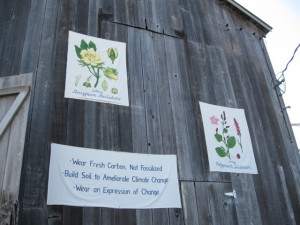
The Mann Family Barn
The 100 year old barn on the Mann Family Farm in Bolinas was the site of Fibershed’s gala “Grow Your Jeans” fashion show on October 3rd. This was part celebration and part advertisement for the locavore movement as it applies to the clothes on our backs. Rebecca Burgess and Sally Fox teamed up with Leslie Terzian Markoff and Dan DiSanto to produce a few pairs of denim jeans by hand, with ingredients and labor sourced within 150 miles of Bolinas. Rebecca grew the indigo to dye the cotton that Sally grew in the Capay Valley. Leslie wove the narrow fabric for Dan, who designed and tailored the pants. They were pre-sold and custom tailored for the buyers. There was a raffle at the end of the evening for a pair of the custom made jeans.
To complete the jeans wardrobe, spinners and weavers and knitters were asked to use local wool and other protein fibers and to design “Grass-Fed Tops and Accessories.” Some 81 separate people, from the farmers to the artisans and mills joined together to create the garments.
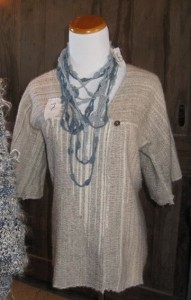 |
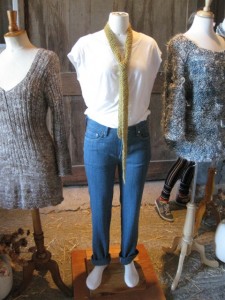 |
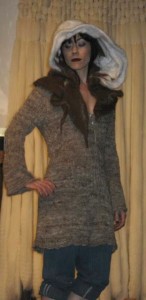 |
This is “back to the land” in the most basic sense. Instead of buying many clothes at the lowest price, made with cheap labor and polluting methods in off shore factories, these artisans say we should think about investing in fewer, more carefully made garments, providing work for local craftsmen and enriching the land in the process. Sheep are raised organically, within 150 miles of where the wool is processed, spun and knit or woven. Cotton came from farms as organic as possible–“cleaner cotton” they’re calling it—is farmed with fewer harmful chemicals. Indigo is grown all summer, picked and dried, fermented on a floor of clay and rice straw, and ground into powder in the winter. Then it is turned by alchemy into a yellow vat for dyeing cotton, silk, and wool, the yellow goods magically oxidizing blue when exposed to air.
About 200 people milled about before the fashion show feeling the garments and sampling the food offerings. Spicy braised beef hearts, tubs of vibrant green pesto and black olive spread, plates of stuffed peppers, deviled eggs, local cheeses, and chicken rice soup served in wee cardboard cups which were, of course, recyclable and compostable–as are the all-cotton jeans and the woolly sweaters when they are worn out.
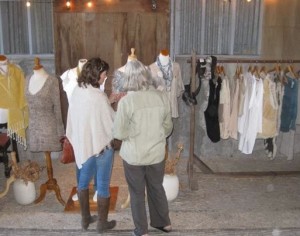
Shopping at Grow Your Own Jeans
There were interactive demonstration booths, a table where one could pound an indigo leaf between a fold of cloth until the color transferred to the cloth. Left to hang in the air, the leaf print would slowly oxidize into blue. Others were dipping pieces of fabric into an indigo vat, to emerge yellow and turn blue, with white spots where the bottle cap resists were clamped. Susan Sullivan Maynard was spinning cotton on a delicate Japanese wheel built for silk and explaining the process to those watching.
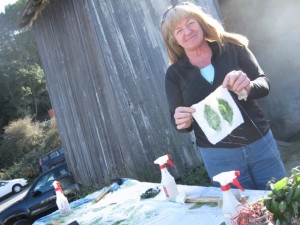
Indigo Prints
There were bouquets of indigo with their pink or white blossoms and branches of Sally’s brown cotton bolls decorating the entrance to the barn, and the stage was decorated with large hangings made of wool roving woven with copper wire, and big baskets of fleece and enamel tubs of cotton. Behind the building there was a marketplace where 19 vendors sold their wares, all produced locally: felted vests and plant-dyed yarn and bags of fleece in a rainbow of colors and socks knit from wool vying with those knit from colored cotton.
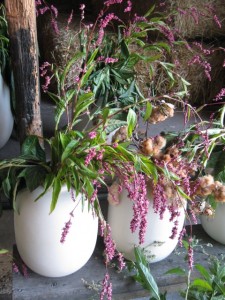
Bouquets
Before the models paraded down a runway of hay bales, the quartet of creators spoke about the project. Rebecca thanked the food and fiber farmers, comparing the healthy slow food movement with what she is trying to do for clothing. The fashion industry thrives on superficiality, she said, and Fibershed is trying to return us to regional plant-based systems where there is equity between the value of labor and the cost of the item produced, and where the production of clothing enriches the soil instead of depleting or polluting it. By wearing cotton and wool and flax instead of petroleum based fibers, and coloring them naturally instead of with coal-based dyes, we are helping to save the planet.
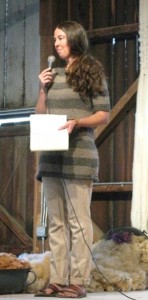
Rebecca Burgess
Sally Fox of Vreseis Limited talked about how she got into growing colored cotton, and how in ten years she developed a colored cotton which is machine pickable, machine spin-able, water-fast and strong. She had built her hybrids into a thriving business but her market vanished after other countries started growing colored cotton and undercutting her prices. She was left with only her seed stock and a piece of land where it was illegal to grow colored cotton. She managed to swap that farm for land in the Capay Valley in northern California and was about to give up when Rebecca came and saved her, bringing her customers from among the young, enthusiastic artisans joining Fibershed.
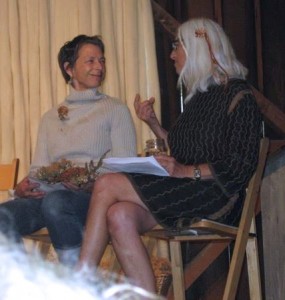
Leslie Terzian Markoff and Sally Fox
Leslie spoke about weaving the narrow warp denim, how she had been so interested in the project, but had no idea how long it would take.
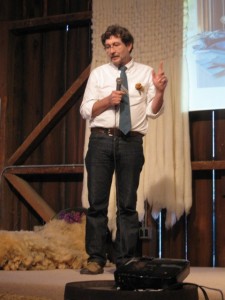
Dan DiSanto
Dan spoke warmly about how perfect Leslie’s selvedges were, and how little waste there was in the cutting when you have narrow warps, and about the woman who wove the pockets on an even narrower warp, with red selvedges, which only show on the inside, but make the pants so much more “finished.” He praised the softness of Sally’s cotton, how it drapes and molds just like wool, and is even soft enough to use for a necktie, which he was wearing. He closed by saying it was time for a reversal of the “apparel chain.” It should operate from the bottom up, not from the top down as it does today, where fashion dictators decide what all the consumers will want this season, and this huge global apparatus swings into motion making millions of pairs of hot pink shorts, which flood the market in no time at all, selling for $6.99, until everyone is sick of them, at which time they all end up in the 99 cent bin at Marshall’s, or get donated to overseas charities. He thinks it is time instead for something called “new vintage” fashion, determined by what’s available and local and good for the earth.
Then it was time for the models to show off all the interesting creations. Many of the pieces were thick and woolly, but there were some very fine garments. A woven top was fine and flexible and moved well on the model. The brown sweater with white lace sleeves, and the Cormo wool summer top were both very soft and delicate. There was an excellent machine knit shirt with raised geometric designs. Most of the pieces were for sale, their prices reflecting the amount of work that went in to their making. A notice in the program drew attention to the fact that it may take 60 hours to hand spin yarn for a project.
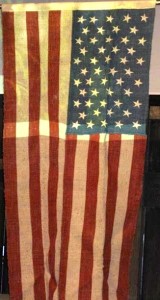
American Flag made from Hemp
The end of the show was an American flag, the first one to be made of hemp in 150 years. It was woven in Kentucky, with threads dyed with indigo and madder as in the original, and the stars were appliquéd by Rwandan refugees in a jobs program in Louisville.
The crowd was very appreciative of the show and of the aims of the organization, and the flag got huge applause.